Comprehensive Report on Management Accounting Principles at Tesco
VerifiedAdded on 2021/02/19
|14
|2931
|217
Report
AI Summary
This report provides a comprehensive overview of management accounting, focusing on its role within an organization, particularly using Tesco as a case study. It delves into the various types of costs, including direct, indirect, fixed, and variable costs, and their classification based on function and behavior. The report then explores the effectiveness of marginal costing systems, outlining their advantages and disadvantages for businesses. Furthermore, it examines the objectives of budgeting, emphasizing its role in promoting organizational effectiveness through structure, cash flow prediction, resource allocation, performance measurement, and goal communication. The analysis highlights how these accounting tools contribute to decision-making, forecasting, and overall financial management within the retail sector.
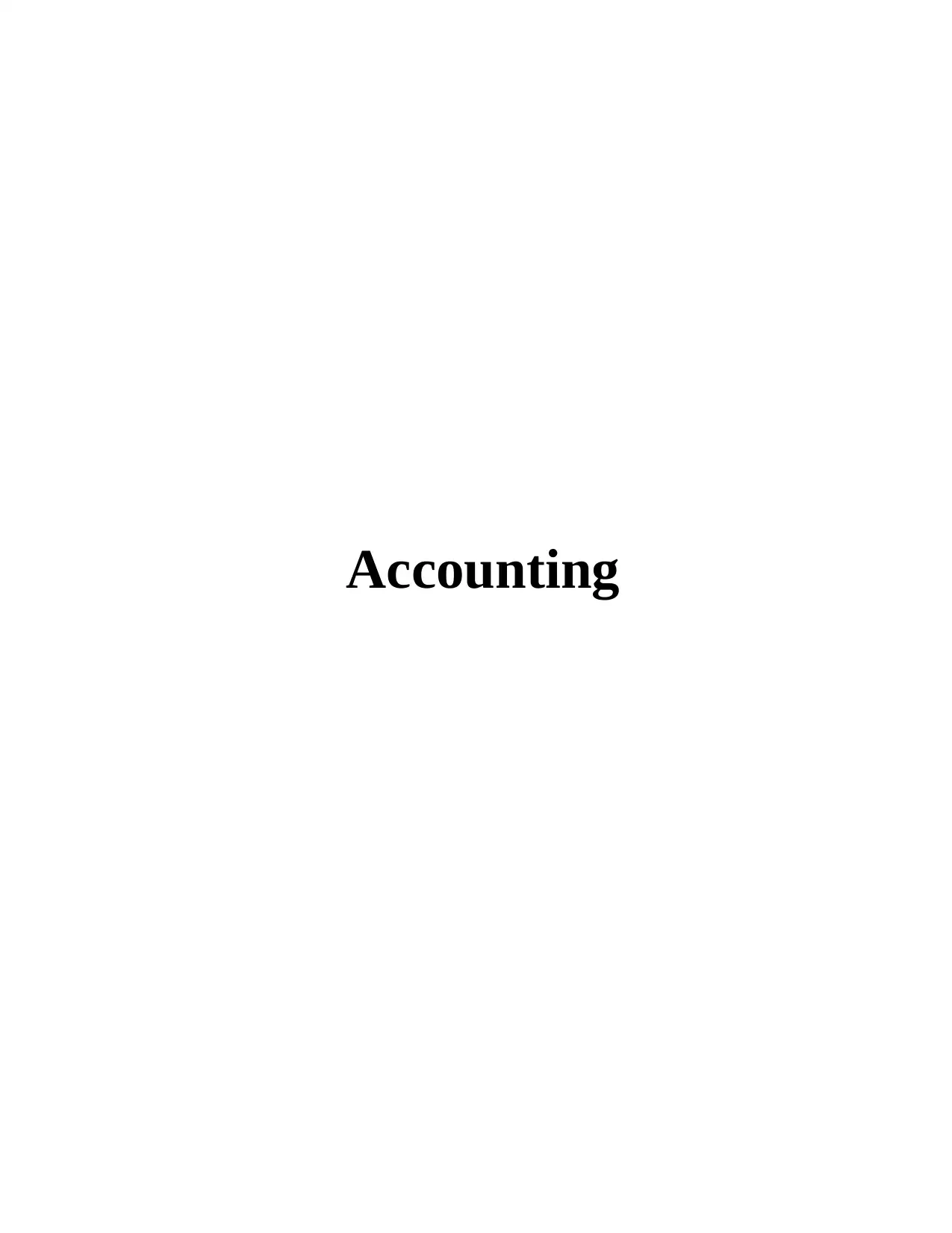
Accounting
Paraphrase This Document
Need a fresh take? Get an instant paraphrase of this document with our AI Paraphraser
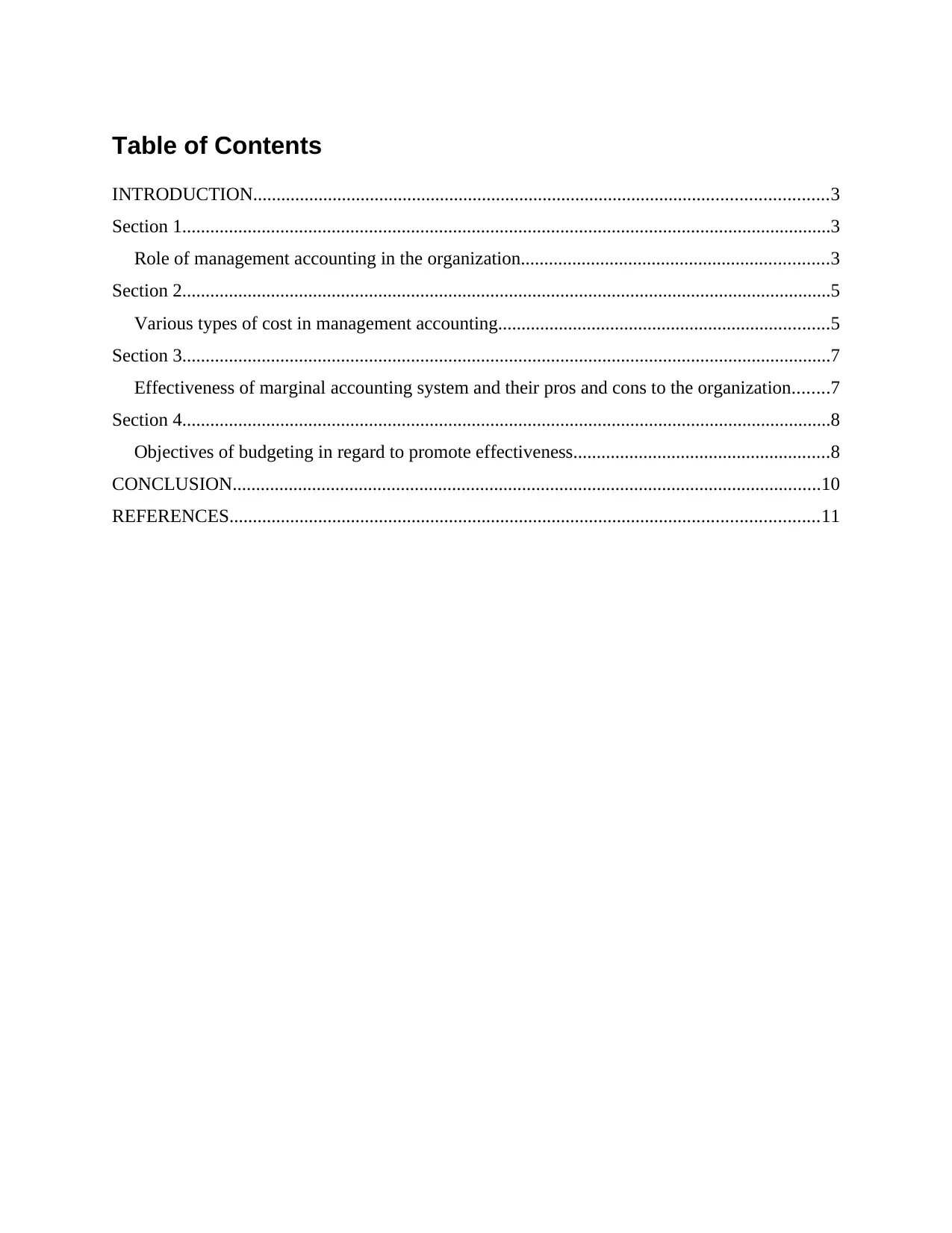
Table of Contents
INTRODUCTION...........................................................................................................................3
Section 1...........................................................................................................................................3
Role of management accounting in the organization..................................................................3
Section 2...........................................................................................................................................5
Various types of cost in management accounting.......................................................................5
Section 3...........................................................................................................................................7
Effectiveness of marginal accounting system and their pros and cons to the organization........7
Section 4...........................................................................................................................................8
Objectives of budgeting in regard to promote effectiveness.......................................................8
CONCLUSION..............................................................................................................................10
REFERENCES..............................................................................................................................11
INTRODUCTION...........................................................................................................................3
Section 1...........................................................................................................................................3
Role of management accounting in the organization..................................................................3
Section 2...........................................................................................................................................5
Various types of cost in management accounting.......................................................................5
Section 3...........................................................................................................................................7
Effectiveness of marginal accounting system and their pros and cons to the organization........7
Section 4...........................................................................................................................................8
Objectives of budgeting in regard to promote effectiveness.......................................................8
CONCLUSION..............................................................................................................................10
REFERENCES..............................................................................................................................11
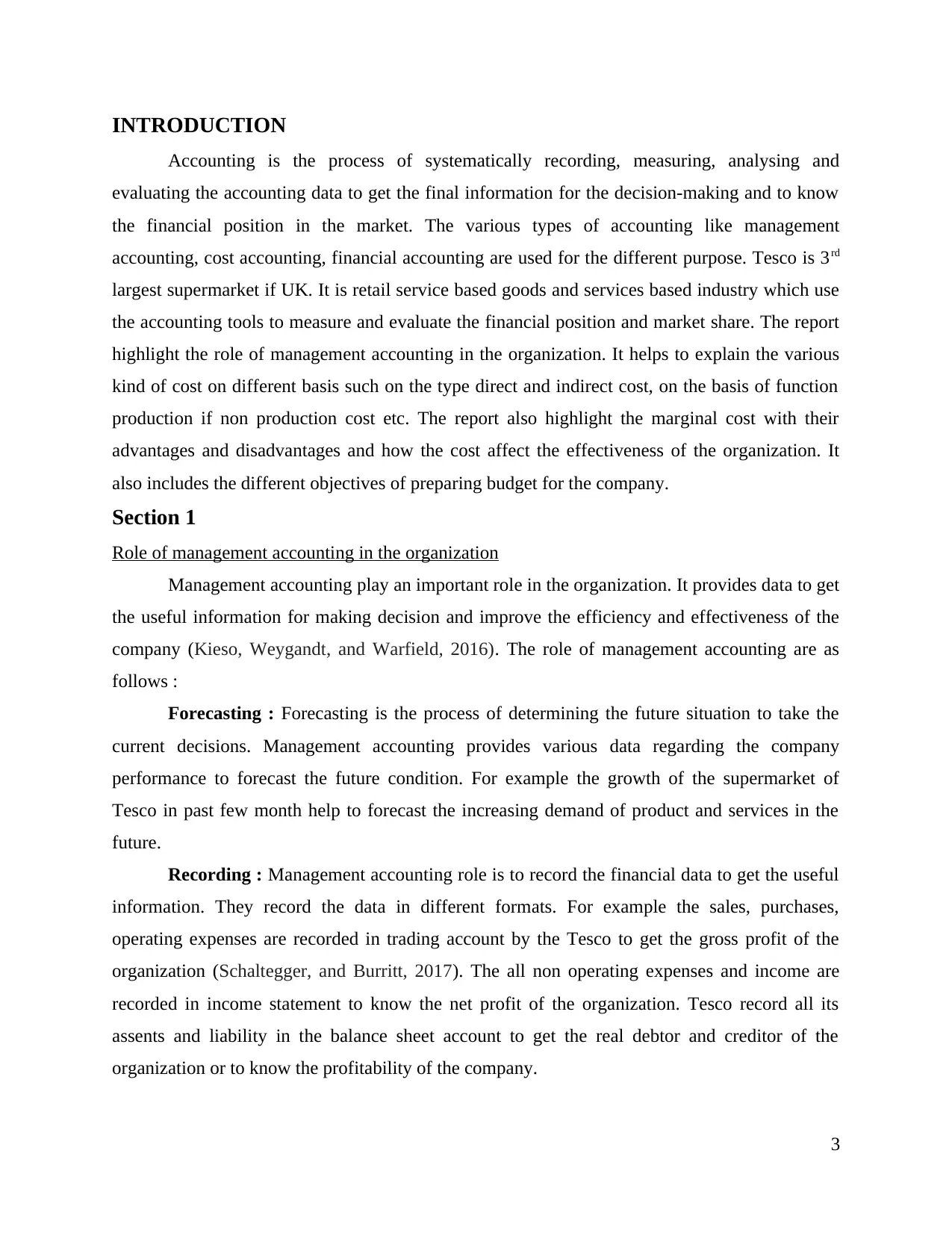
INTRODUCTION
Accounting is the process of systematically recording, measuring, analysing and
evaluating the accounting data to get the final information for the decision-making and to know
the financial position in the market. The various types of accounting like management
accounting, cost accounting, financial accounting are used for the different purpose. Tesco is 3rd
largest supermarket if UK. It is retail service based goods and services based industry which use
the accounting tools to measure and evaluate the financial position and market share. The report
highlight the role of management accounting in the organization. It helps to explain the various
kind of cost on different basis such on the type direct and indirect cost, on the basis of function
production if non production cost etc. The report also highlight the marginal cost with their
advantages and disadvantages and how the cost affect the effectiveness of the organization. It
also includes the different objectives of preparing budget for the company.
Section 1
Role of management accounting in the organization
Management accounting play an important role in the organization. It provides data to get
the useful information for making decision and improve the efficiency and effectiveness of the
company (Kieso, Weygandt, and Warfield, 2016). The role of management accounting are as
follows :
Forecasting : Forecasting is the process of determining the future situation to take the
current decisions. Management accounting provides various data regarding the company
performance to forecast the future condition. For example the growth of the supermarket of
Tesco in past few month help to forecast the increasing demand of product and services in the
future.
Recording : Management accounting role is to record the financial data to get the useful
information. They record the data in different formats. For example the sales, purchases,
operating expenses are recorded in trading account by the Tesco to get the gross profit of the
organization (Schaltegger, and Burritt, 2017). The all non operating expenses and income are
recorded in income statement to know the net profit of the organization. Tesco record all its
assents and liability in the balance sheet account to get the real debtor and creditor of the
organization or to know the profitability of the company.
3
Accounting is the process of systematically recording, measuring, analysing and
evaluating the accounting data to get the final information for the decision-making and to know
the financial position in the market. The various types of accounting like management
accounting, cost accounting, financial accounting are used for the different purpose. Tesco is 3rd
largest supermarket if UK. It is retail service based goods and services based industry which use
the accounting tools to measure and evaluate the financial position and market share. The report
highlight the role of management accounting in the organization. It helps to explain the various
kind of cost on different basis such on the type direct and indirect cost, on the basis of function
production if non production cost etc. The report also highlight the marginal cost with their
advantages and disadvantages and how the cost affect the effectiveness of the organization. It
also includes the different objectives of preparing budget for the company.
Section 1
Role of management accounting in the organization
Management accounting play an important role in the organization. It provides data to get
the useful information for making decision and improve the efficiency and effectiveness of the
company (Kieso, Weygandt, and Warfield, 2016). The role of management accounting are as
follows :
Forecasting : Forecasting is the process of determining the future situation to take the
current decisions. Management accounting provides various data regarding the company
performance to forecast the future condition. For example the growth of the supermarket of
Tesco in past few month help to forecast the increasing demand of product and services in the
future.
Recording : Management accounting role is to record the financial data to get the useful
information. They record the data in different formats. For example the sales, purchases,
operating expenses are recorded in trading account by the Tesco to get the gross profit of the
organization (Schaltegger, and Burritt, 2017). The all non operating expenses and income are
recorded in income statement to know the net profit of the organization. Tesco record all its
assents and liability in the balance sheet account to get the real debtor and creditor of the
organization or to know the profitability of the company.
3
⊘ This is a preview!⊘
Do you want full access?
Subscribe today to unlock all pages.

Trusted by 1+ million students worldwide
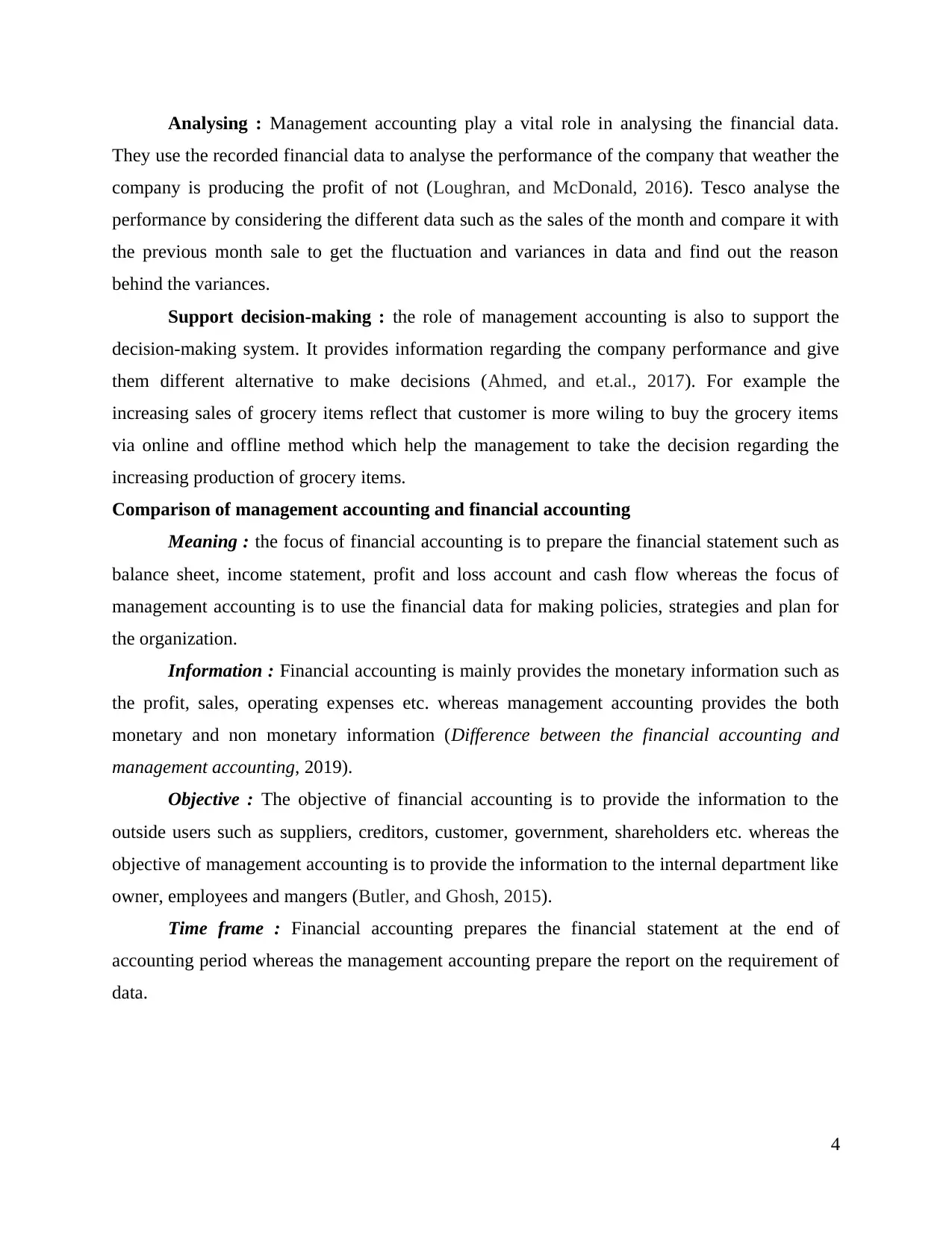
Analysing : Management accounting play a vital role in analysing the financial data.
They use the recorded financial data to analyse the performance of the company that weather the
company is producing the profit of not (Loughran, and McDonald, 2016). Tesco analyse the
performance by considering the different data such as the sales of the month and compare it with
the previous month sale to get the fluctuation and variances in data and find out the reason
behind the variances.
Support decision-making : the role of management accounting is also to support the
decision-making system. It provides information regarding the company performance and give
them different alternative to make decisions (Ahmed, and et.al., 2017). For example the
increasing sales of grocery items reflect that customer is more wiling to buy the grocery items
via online and offline method which help the management to take the decision regarding the
increasing production of grocery items.
Comparison of management accounting and financial accounting
Meaning : the focus of financial accounting is to prepare the financial statement such as
balance sheet, income statement, profit and loss account and cash flow whereas the focus of
management accounting is to use the financial data for making policies, strategies and plan for
the organization.
Information : Financial accounting is mainly provides the monetary information such as
the profit, sales, operating expenses etc. whereas management accounting provides the both
monetary and non monetary information (Difference between the financial accounting and
management accounting, 2019).
Objective : The objective of financial accounting is to provide the information to the
outside users such as suppliers, creditors, customer, government, shareholders etc. whereas the
objective of management accounting is to provide the information to the internal department like
owner, employees and mangers (Butler, and Ghosh, 2015).
Time frame : Financial accounting prepares the financial statement at the end of
accounting period whereas the management accounting prepare the report on the requirement of
data.
4
They use the recorded financial data to analyse the performance of the company that weather the
company is producing the profit of not (Loughran, and McDonald, 2016). Tesco analyse the
performance by considering the different data such as the sales of the month and compare it with
the previous month sale to get the fluctuation and variances in data and find out the reason
behind the variances.
Support decision-making : the role of management accounting is also to support the
decision-making system. It provides information regarding the company performance and give
them different alternative to make decisions (Ahmed, and et.al., 2017). For example the
increasing sales of grocery items reflect that customer is more wiling to buy the grocery items
via online and offline method which help the management to take the decision regarding the
increasing production of grocery items.
Comparison of management accounting and financial accounting
Meaning : the focus of financial accounting is to prepare the financial statement such as
balance sheet, income statement, profit and loss account and cash flow whereas the focus of
management accounting is to use the financial data for making policies, strategies and plan for
the organization.
Information : Financial accounting is mainly provides the monetary information such as
the profit, sales, operating expenses etc. whereas management accounting provides the both
monetary and non monetary information (Difference between the financial accounting and
management accounting, 2019).
Objective : The objective of financial accounting is to provide the information to the
outside users such as suppliers, creditors, customer, government, shareholders etc. whereas the
objective of management accounting is to provide the information to the internal department like
owner, employees and mangers (Butler, and Ghosh, 2015).
Time frame : Financial accounting prepares the financial statement at the end of
accounting period whereas the management accounting prepare the report on the requirement of
data.
4
Paraphrase This Document
Need a fresh take? Get an instant paraphrase of this document with our AI Paraphraser
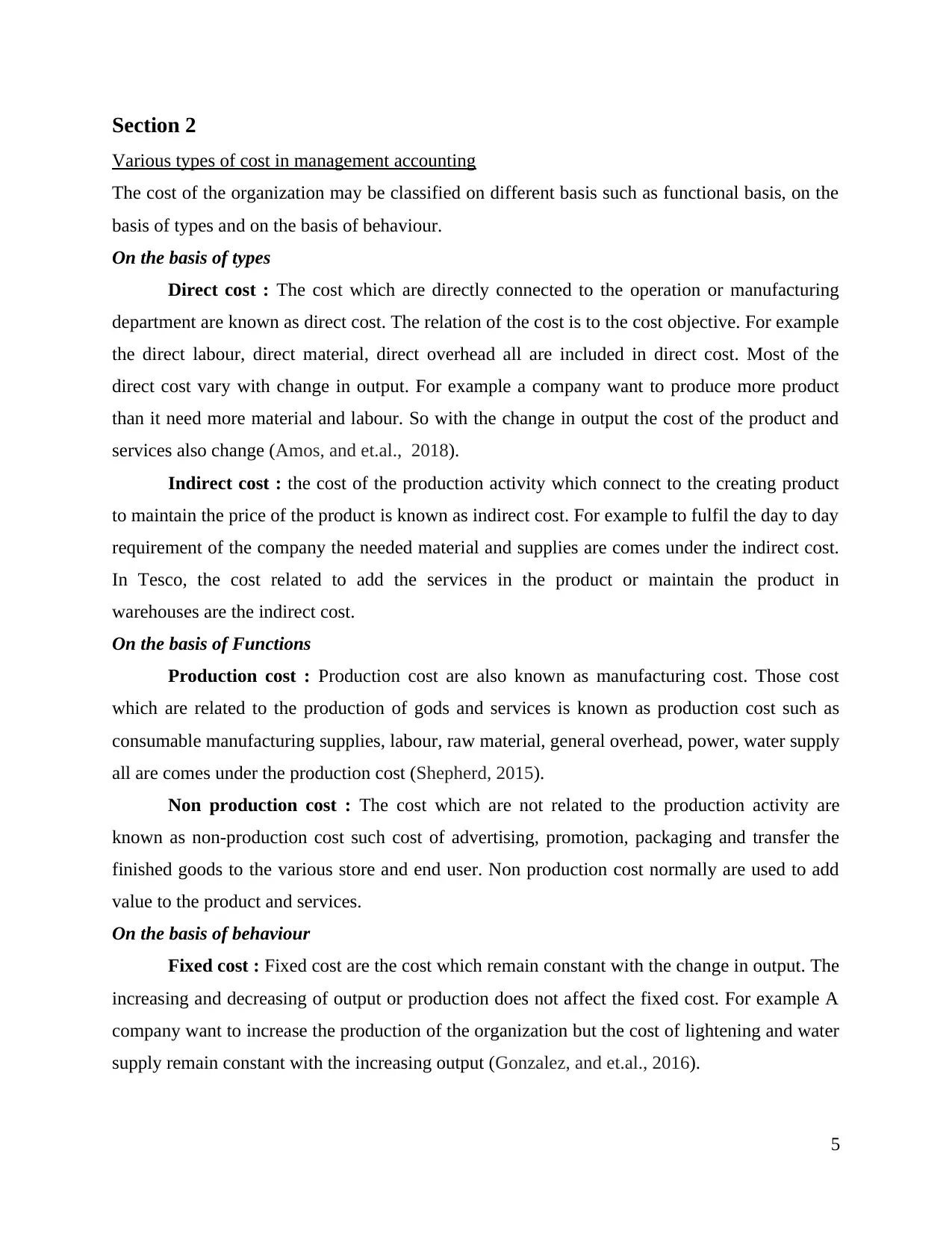
Section 2
Various types of cost in management accounting
The cost of the organization may be classified on different basis such as functional basis, on the
basis of types and on the basis of behaviour.
On the basis of types
Direct cost : The cost which are directly connected to the operation or manufacturing
department are known as direct cost. The relation of the cost is to the cost objective. For example
the direct labour, direct material, direct overhead all are included in direct cost. Most of the
direct cost vary with change in output. For example a company want to produce more product
than it need more material and labour. So with the change in output the cost of the product and
services also change (Amos, and et.al., 2018).
Indirect cost : the cost of the production activity which connect to the creating product
to maintain the price of the product is known as indirect cost. For example to fulfil the day to day
requirement of the company the needed material and supplies are comes under the indirect cost.
In Tesco, the cost related to add the services in the product or maintain the product in
warehouses are the indirect cost.
On the basis of Functions
Production cost : Production cost are also known as manufacturing cost. Those cost
which are related to the production of gods and services is known as production cost such as
consumable manufacturing supplies, labour, raw material, general overhead, power, water supply
all are comes under the production cost (Shepherd, 2015).
Non production cost : The cost which are not related to the production activity are
known as non-production cost such cost of advertising, promotion, packaging and transfer the
finished goods to the various store and end user. Non production cost normally are used to add
value to the product and services.
On the basis of behaviour
Fixed cost : Fixed cost are the cost which remain constant with the change in output. The
increasing and decreasing of output or production does not affect the fixed cost. For example A
company want to increase the production of the organization but the cost of lightening and water
supply remain constant with the increasing output (Gonzalez, and et.al., 2016).
5
Various types of cost in management accounting
The cost of the organization may be classified on different basis such as functional basis, on the
basis of types and on the basis of behaviour.
On the basis of types
Direct cost : The cost which are directly connected to the operation or manufacturing
department are known as direct cost. The relation of the cost is to the cost objective. For example
the direct labour, direct material, direct overhead all are included in direct cost. Most of the
direct cost vary with change in output. For example a company want to produce more product
than it need more material and labour. So with the change in output the cost of the product and
services also change (Amos, and et.al., 2018).
Indirect cost : the cost of the production activity which connect to the creating product
to maintain the price of the product is known as indirect cost. For example to fulfil the day to day
requirement of the company the needed material and supplies are comes under the indirect cost.
In Tesco, the cost related to add the services in the product or maintain the product in
warehouses are the indirect cost.
On the basis of Functions
Production cost : Production cost are also known as manufacturing cost. Those cost
which are related to the production of gods and services is known as production cost such as
consumable manufacturing supplies, labour, raw material, general overhead, power, water supply
all are comes under the production cost (Shepherd, 2015).
Non production cost : The cost which are not related to the production activity are
known as non-production cost such cost of advertising, promotion, packaging and transfer the
finished goods to the various store and end user. Non production cost normally are used to add
value to the product and services.
On the basis of behaviour
Fixed cost : Fixed cost are the cost which remain constant with the change in output. The
increasing and decreasing of output or production does not affect the fixed cost. For example A
company want to increase the production of the organization but the cost of lightening and water
supply remain constant with the increasing output (Gonzalez, and et.al., 2016).
5
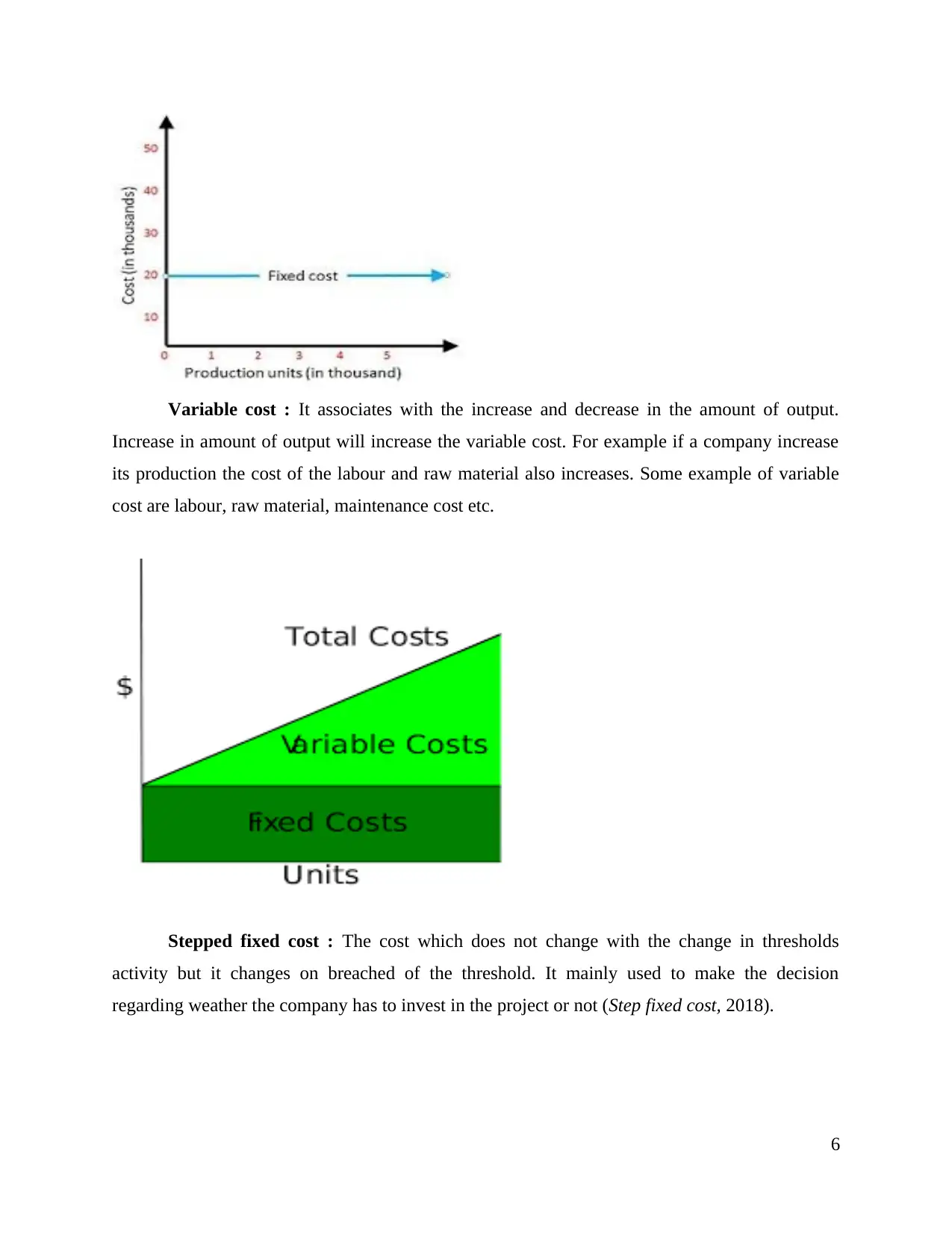
Variable cost : It associates with the increase and decrease in the amount of output.
Increase in amount of output will increase the variable cost. For example if a company increase
its production the cost of the labour and raw material also increases. Some example of variable
cost are labour, raw material, maintenance cost etc.
Stepped fixed cost : The cost which does not change with the change in thresholds
activity but it changes on breached of the threshold. It mainly used to make the decision
regarding weather the company has to invest in the project or not (Step fixed cost, 2018).
6
Increase in amount of output will increase the variable cost. For example if a company increase
its production the cost of the labour and raw material also increases. Some example of variable
cost are labour, raw material, maintenance cost etc.
Stepped fixed cost : The cost which does not change with the change in thresholds
activity but it changes on breached of the threshold. It mainly used to make the decision
regarding weather the company has to invest in the project or not (Step fixed cost, 2018).
6
⊘ This is a preview!⊘
Do you want full access?
Subscribe today to unlock all pages.

Trusted by 1+ million students worldwide
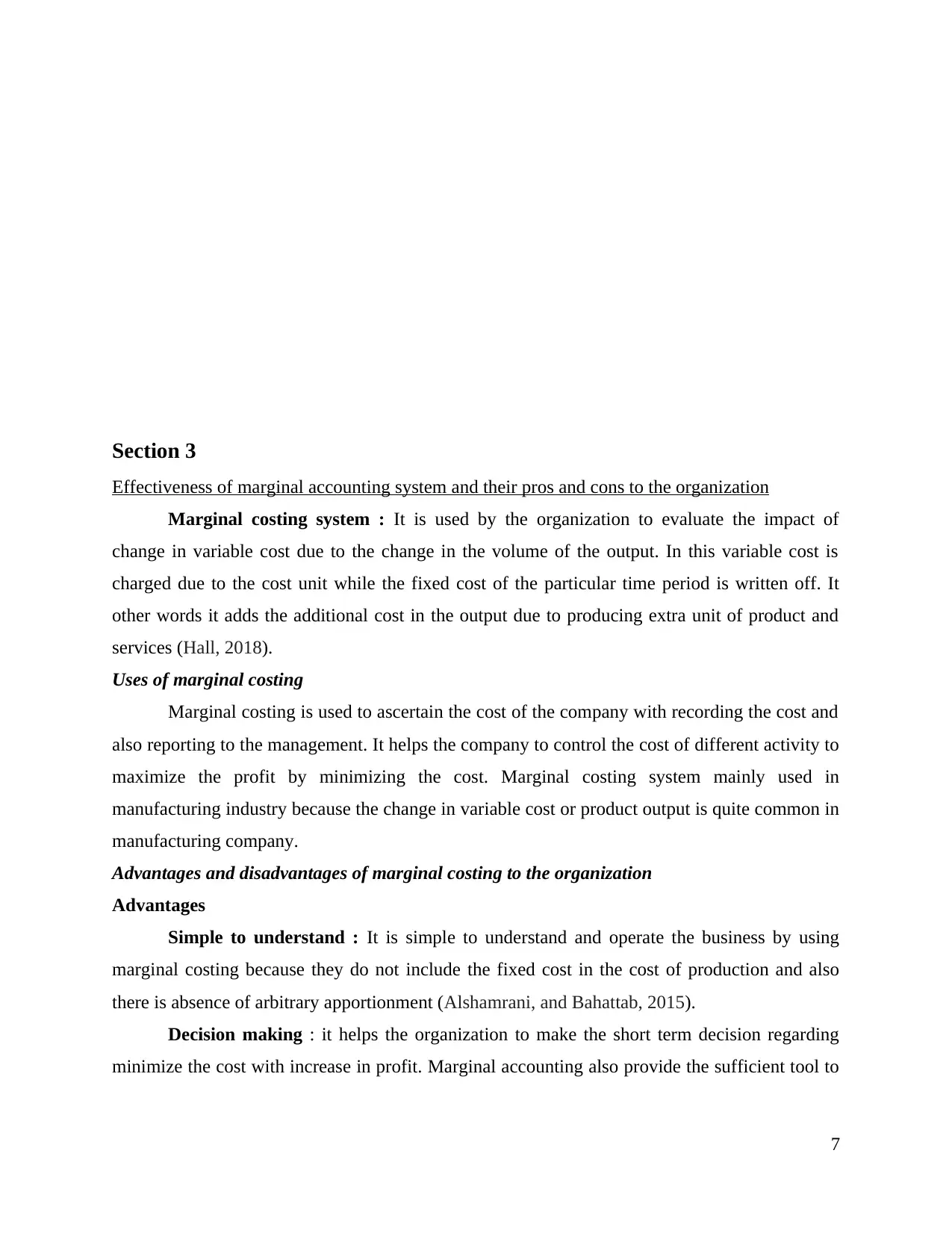
Section 3
Effectiveness of marginal accounting system and their pros and cons to the organization
Marginal costing system : It is used by the organization to evaluate the impact of
change in variable cost due to the change in the volume of the output. In this variable cost is
charged due to the cost unit while the fixed cost of the particular time period is written off. It
other words it adds the additional cost in the output due to producing extra unit of product and
services (Hall, 2018).
Uses of marginal costing
Marginal costing is used to ascertain the cost of the company with recording the cost and
also reporting to the management. It helps the company to control the cost of different activity to
maximize the profit by minimizing the cost. Marginal costing system mainly used in
manufacturing industry because the change in variable cost or product output is quite common in
manufacturing company.
Advantages and disadvantages of marginal costing to the organization
Advantages
Simple to understand : It is simple to understand and operate the business by using
marginal costing because they do not include the fixed cost in the cost of production and also
there is absence of arbitrary apportionment (Alshamrani, and Bahattab, 2015).
Decision making : it helps the organization to make the short term decision regarding
minimize the cost with increase in profit. Marginal accounting also provide the sufficient tool to
7
Effectiveness of marginal accounting system and their pros and cons to the organization
Marginal costing system : It is used by the organization to evaluate the impact of
change in variable cost due to the change in the volume of the output. In this variable cost is
charged due to the cost unit while the fixed cost of the particular time period is written off. It
other words it adds the additional cost in the output due to producing extra unit of product and
services (Hall, 2018).
Uses of marginal costing
Marginal costing is used to ascertain the cost of the company with recording the cost and
also reporting to the management. It helps the company to control the cost of different activity to
maximize the profit by minimizing the cost. Marginal costing system mainly used in
manufacturing industry because the change in variable cost or product output is quite common in
manufacturing company.
Advantages and disadvantages of marginal costing to the organization
Advantages
Simple to understand : It is simple to understand and operate the business by using
marginal costing because they do not include the fixed cost in the cost of production and also
there is absence of arbitrary apportionment (Alshamrani, and Bahattab, 2015).
Decision making : it helps the organization to make the short term decision regarding
minimize the cost with increase in profit. Marginal accounting also provide the sufficient tool to
7
Paraphrase This Document
Need a fresh take? Get an instant paraphrase of this document with our AI Paraphraser
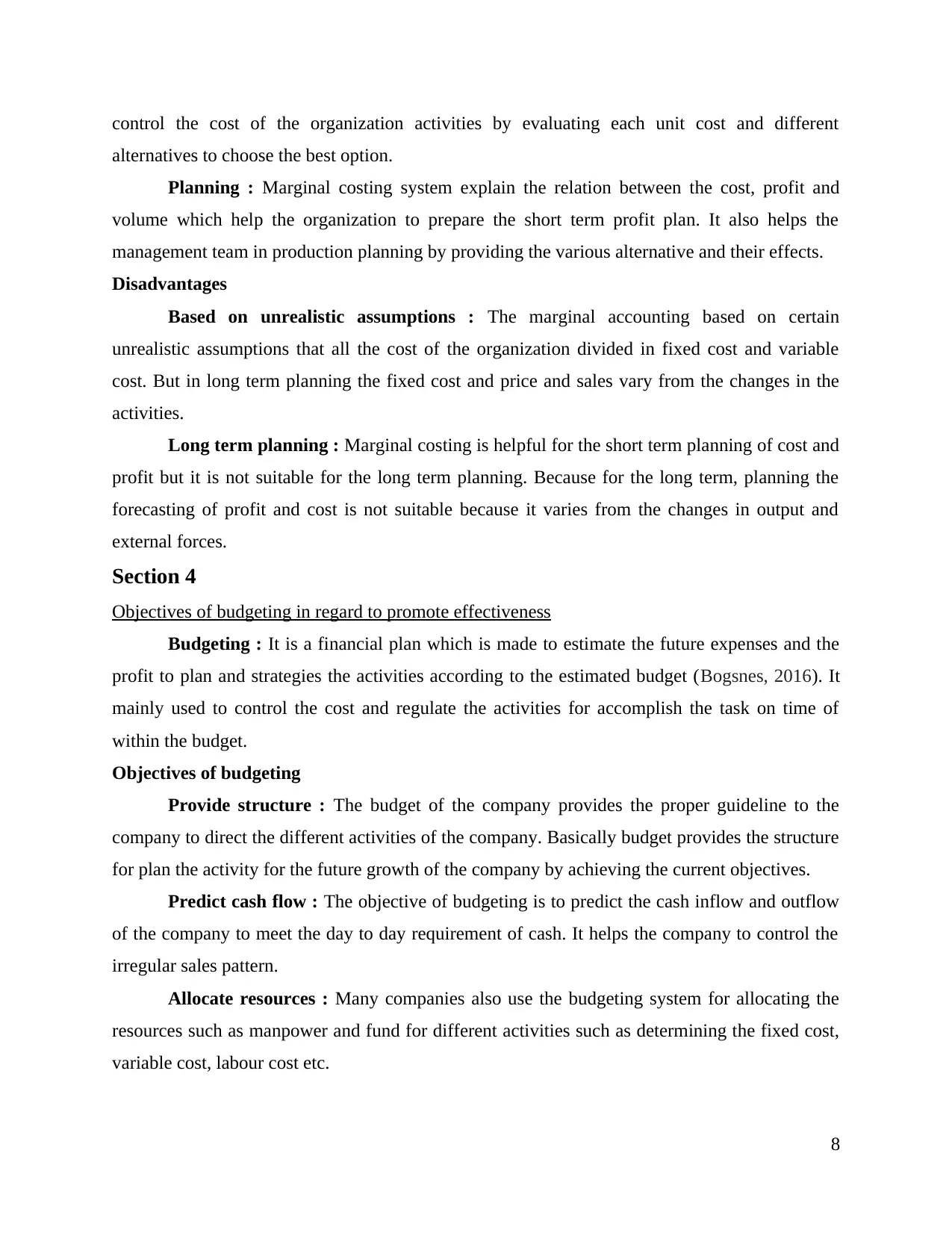
control the cost of the organization activities by evaluating each unit cost and different
alternatives to choose the best option.
Planning : Marginal costing system explain the relation between the cost, profit and
volume which help the organization to prepare the short term profit plan. It also helps the
management team in production planning by providing the various alternative and their effects.
Disadvantages
Based on unrealistic assumptions : The marginal accounting based on certain
unrealistic assumptions that all the cost of the organization divided in fixed cost and variable
cost. But in long term planning the fixed cost and price and sales vary from the changes in the
activities.
Long term planning : Marginal costing is helpful for the short term planning of cost and
profit but it is not suitable for the long term planning. Because for the long term, planning the
forecasting of profit and cost is not suitable because it varies from the changes in output and
external forces.
Section 4
Objectives of budgeting in regard to promote effectiveness
Budgeting : It is a financial plan which is made to estimate the future expenses and the
profit to plan and strategies the activities according to the estimated budget (Bogsnes, 2016). It
mainly used to control the cost and regulate the activities for accomplish the task on time of
within the budget.
Objectives of budgeting
Provide structure : The budget of the company provides the proper guideline to the
company to direct the different activities of the company. Basically budget provides the structure
for plan the activity for the future growth of the company by achieving the current objectives.
Predict cash flow : The objective of budgeting is to predict the cash inflow and outflow
of the company to meet the day to day requirement of cash. It helps the company to control the
irregular sales pattern.
Allocate resources : Many companies also use the budgeting system for allocating the
resources such as manpower and fund for different activities such as determining the fixed cost,
variable cost, labour cost etc.
8
alternatives to choose the best option.
Planning : Marginal costing system explain the relation between the cost, profit and
volume which help the organization to prepare the short term profit plan. It also helps the
management team in production planning by providing the various alternative and their effects.
Disadvantages
Based on unrealistic assumptions : The marginal accounting based on certain
unrealistic assumptions that all the cost of the organization divided in fixed cost and variable
cost. But in long term planning the fixed cost and price and sales vary from the changes in the
activities.
Long term planning : Marginal costing is helpful for the short term planning of cost and
profit but it is not suitable for the long term planning. Because for the long term, planning the
forecasting of profit and cost is not suitable because it varies from the changes in output and
external forces.
Section 4
Objectives of budgeting in regard to promote effectiveness
Budgeting : It is a financial plan which is made to estimate the future expenses and the
profit to plan and strategies the activities according to the estimated budget (Bogsnes, 2016). It
mainly used to control the cost and regulate the activities for accomplish the task on time of
within the budget.
Objectives of budgeting
Provide structure : The budget of the company provides the proper guideline to the
company to direct the different activities of the company. Basically budget provides the structure
for plan the activity for the future growth of the company by achieving the current objectives.
Predict cash flow : The objective of budgeting is to predict the cash inflow and outflow
of the company to meet the day to day requirement of cash. It helps the company to control the
irregular sales pattern.
Allocate resources : Many companies also use the budgeting system for allocating the
resources such as manpower and fund for different activities such as determining the fixed cost,
variable cost, labour cost etc.
8
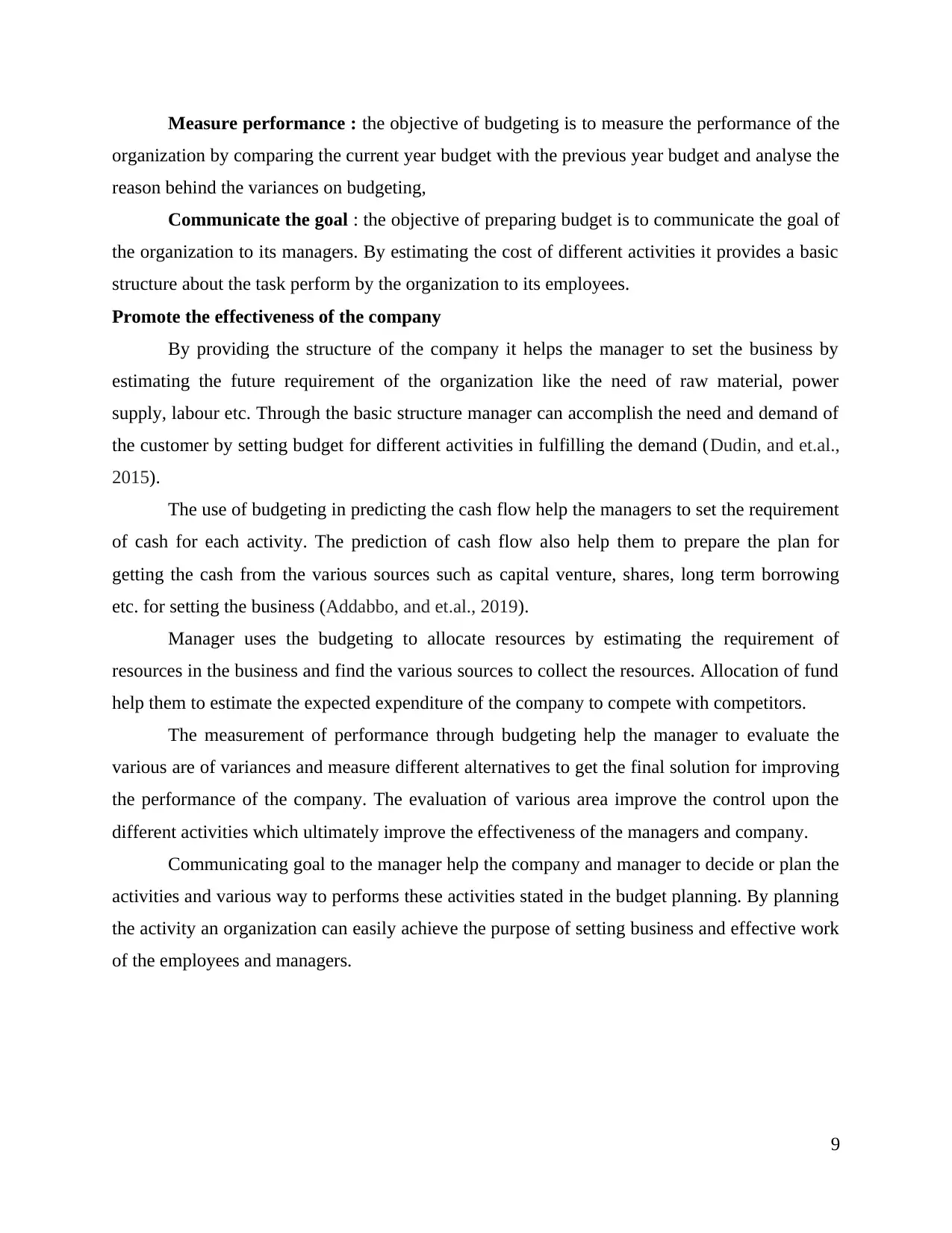
Measure performance : the objective of budgeting is to measure the performance of the
organization by comparing the current year budget with the previous year budget and analyse the
reason behind the variances on budgeting,
Communicate the goal : the objective of preparing budget is to communicate the goal of
the organization to its managers. By estimating the cost of different activities it provides a basic
structure about the task perform by the organization to its employees.
Promote the effectiveness of the company
By providing the structure of the company it helps the manager to set the business by
estimating the future requirement of the organization like the need of raw material, power
supply, labour etc. Through the basic structure manager can accomplish the need and demand of
the customer by setting budget for different activities in fulfilling the demand (Dudin, and et.al.,
2015).
The use of budgeting in predicting the cash flow help the managers to set the requirement
of cash for each activity. The prediction of cash flow also help them to prepare the plan for
getting the cash from the various sources such as capital venture, shares, long term borrowing
etc. for setting the business (Addabbo, and et.al., 2019).
Manager uses the budgeting to allocate resources by estimating the requirement of
resources in the business and find the various sources to collect the resources. Allocation of fund
help them to estimate the expected expenditure of the company to compete with competitors.
The measurement of performance through budgeting help the manager to evaluate the
various are of variances and measure different alternatives to get the final solution for improving
the performance of the company. The evaluation of various area improve the control upon the
different activities which ultimately improve the effectiveness of the managers and company.
Communicating goal to the manager help the company and manager to decide or plan the
activities and various way to performs these activities stated in the budget planning. By planning
the activity an organization can easily achieve the purpose of setting business and effective work
of the employees and managers.
9
organization by comparing the current year budget with the previous year budget and analyse the
reason behind the variances on budgeting,
Communicate the goal : the objective of preparing budget is to communicate the goal of
the organization to its managers. By estimating the cost of different activities it provides a basic
structure about the task perform by the organization to its employees.
Promote the effectiveness of the company
By providing the structure of the company it helps the manager to set the business by
estimating the future requirement of the organization like the need of raw material, power
supply, labour etc. Through the basic structure manager can accomplish the need and demand of
the customer by setting budget for different activities in fulfilling the demand (Dudin, and et.al.,
2015).
The use of budgeting in predicting the cash flow help the managers to set the requirement
of cash for each activity. The prediction of cash flow also help them to prepare the plan for
getting the cash from the various sources such as capital venture, shares, long term borrowing
etc. for setting the business (Addabbo, and et.al., 2019).
Manager uses the budgeting to allocate resources by estimating the requirement of
resources in the business and find the various sources to collect the resources. Allocation of fund
help them to estimate the expected expenditure of the company to compete with competitors.
The measurement of performance through budgeting help the manager to evaluate the
various are of variances and measure different alternatives to get the final solution for improving
the performance of the company. The evaluation of various area improve the control upon the
different activities which ultimately improve the effectiveness of the managers and company.
Communicating goal to the manager help the company and manager to decide or plan the
activities and various way to performs these activities stated in the budget planning. By planning
the activity an organization can easily achieve the purpose of setting business and effective work
of the employees and managers.
9
⊘ This is a preview!⊘
Do you want full access?
Subscribe today to unlock all pages.

Trusted by 1+ million students worldwide
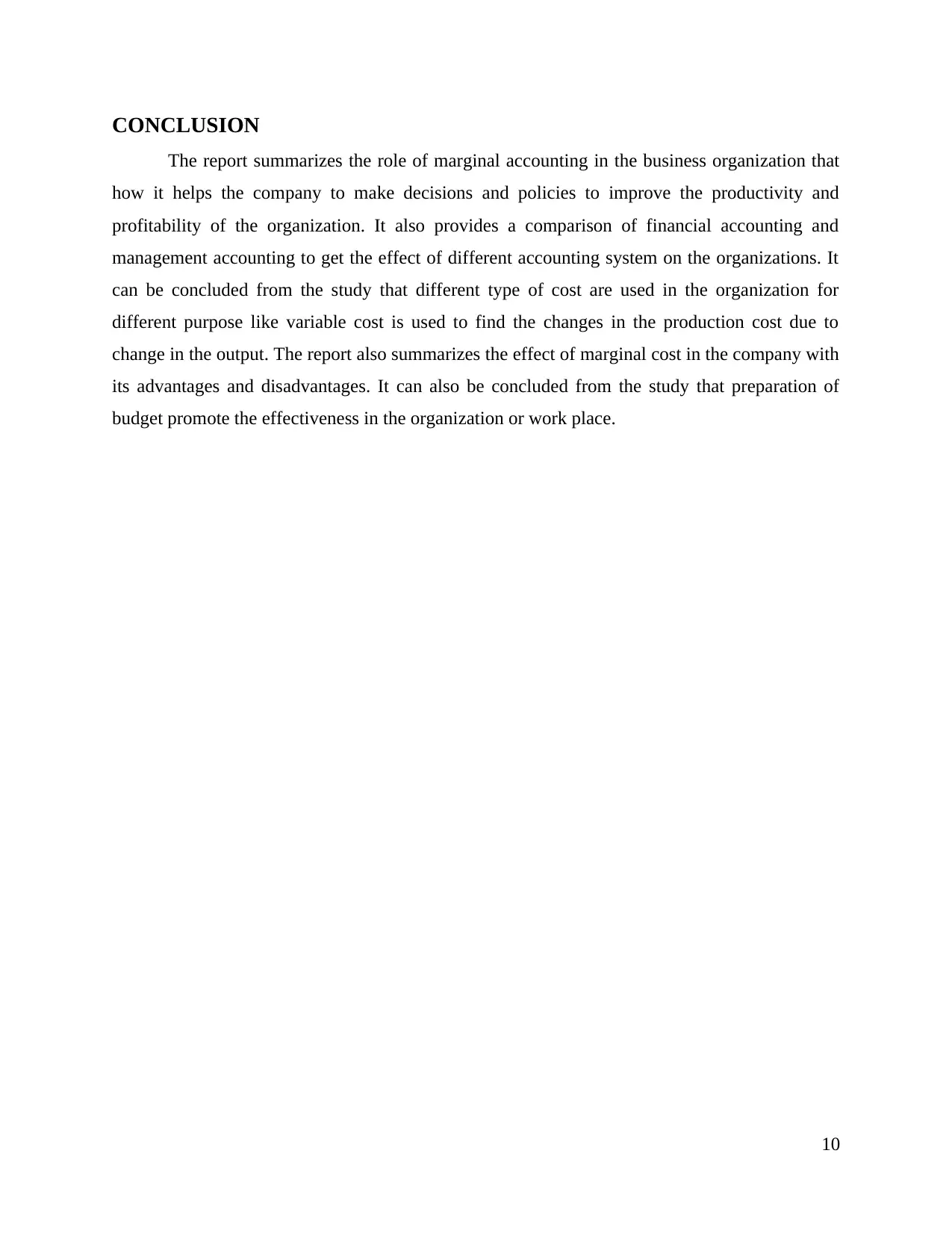
CONCLUSION
The report summarizes the role of marginal accounting in the business organization that
how it helps the company to make decisions and policies to improve the productivity and
profitability of the organization. It also provides a comparison of financial accounting and
management accounting to get the effect of different accounting system on the organizations. It
can be concluded from the study that different type of cost are used in the organization for
different purpose like variable cost is used to find the changes in the production cost due to
change in the output. The report also summarizes the effect of marginal cost in the company with
its advantages and disadvantages. It can also be concluded from the study that preparation of
budget promote the effectiveness in the organization or work place.
10
The report summarizes the role of marginal accounting in the business organization that
how it helps the company to make decisions and policies to improve the productivity and
profitability of the organization. It also provides a comparison of financial accounting and
management accounting to get the effect of different accounting system on the organizations. It
can be concluded from the study that different type of cost are used in the organization for
different purpose like variable cost is used to find the changes in the production cost due to
change in the output. The report also summarizes the effect of marginal cost in the company with
its advantages and disadvantages. It can also be concluded from the study that preparation of
budget promote the effectiveness in the organization or work place.
10
Paraphrase This Document
Need a fresh take? Get an instant paraphrase of this document with our AI Paraphraser
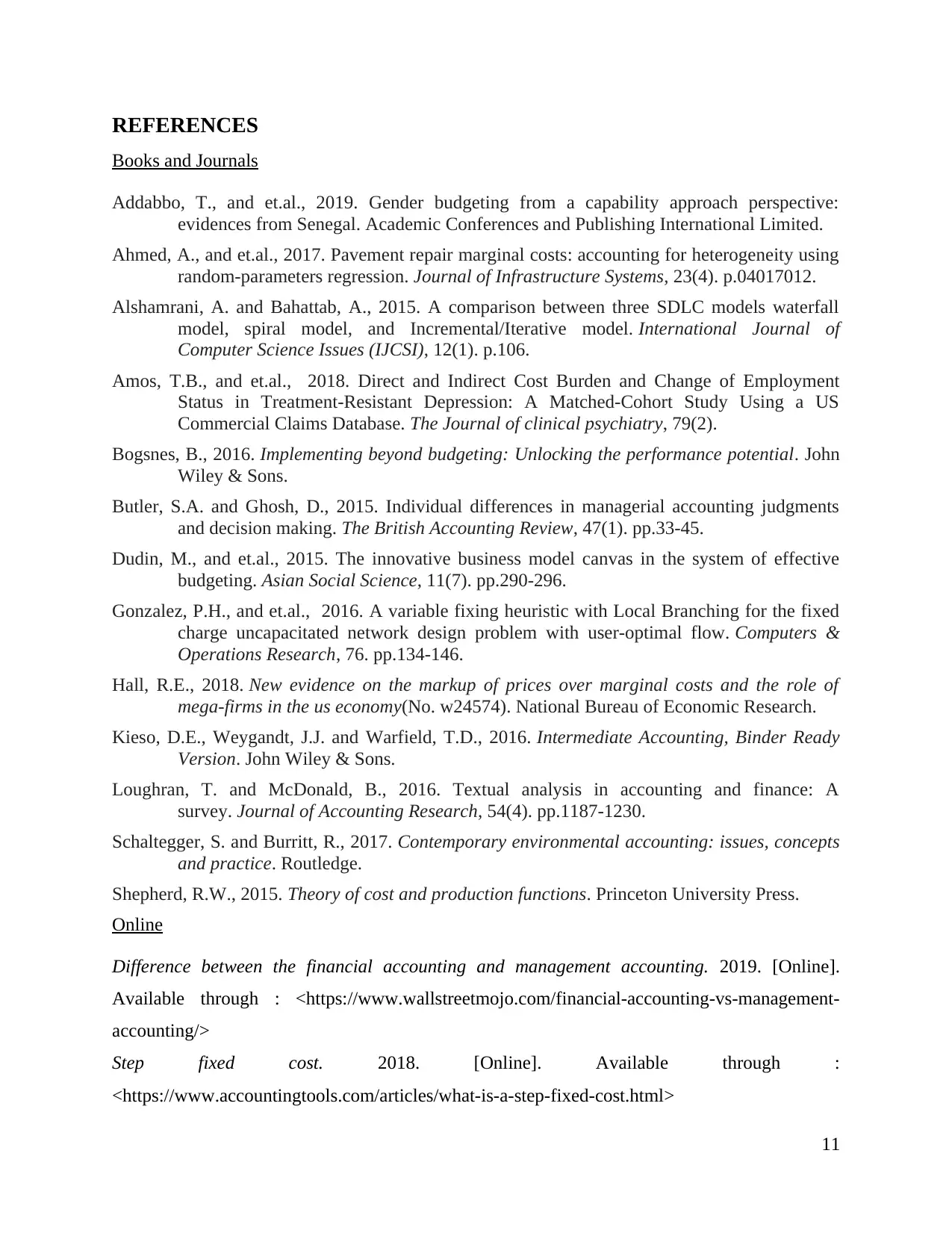
REFERENCES
Books and Journals
Addabbo, T., and et.al., 2019. Gender budgeting from a capability approach perspective:
evidences from Senegal. Academic Conferences and Publishing International Limited.
Ahmed, A., and et.al., 2017. Pavement repair marginal costs: accounting for heterogeneity using
random-parameters regression. Journal of Infrastructure Systems, 23(4). p.04017012.
Alshamrani, A. and Bahattab, A., 2015. A comparison between three SDLC models waterfall
model, spiral model, and Incremental/Iterative model. International Journal of
Computer Science Issues (IJCSI), 12(1). p.106.
Amos, T.B., and et.al., 2018. Direct and Indirect Cost Burden and Change of Employment
Status in Treatment-Resistant Depression: A Matched-Cohort Study Using a US
Commercial Claims Database. The Journal of clinical psychiatry, 79(2).
Bogsnes, B., 2016. Implementing beyond budgeting: Unlocking the performance potential. John
Wiley & Sons.
Butler, S.A. and Ghosh, D., 2015. Individual differences in managerial accounting judgments
and decision making. The British Accounting Review, 47(1). pp.33-45.
Dudin, M., and et.al., 2015. The innovative business model canvas in the system of effective
budgeting. Asian Social Science, 11(7). pp.290-296.
Gonzalez, P.H., and et.al., 2016. A variable fixing heuristic with Local Branching for the fixed
charge uncapacitated network design problem with user-optimal flow. Computers &
Operations Research, 76. pp.134-146.
Hall, R.E., 2018. New evidence on the markup of prices over marginal costs and the role of
mega-firms in the us economy(No. w24574). National Bureau of Economic Research.
Kieso, D.E., Weygandt, J.J. and Warfield, T.D., 2016. Intermediate Accounting, Binder Ready
Version. John Wiley & Sons.
Loughran, T. and McDonald, B., 2016. Textual analysis in accounting and finance: A
survey. Journal of Accounting Research, 54(4). pp.1187-1230.
Schaltegger, S. and Burritt, R., 2017. Contemporary environmental accounting: issues, concepts
and practice. Routledge.
Shepherd, R.W., 2015. Theory of cost and production functions. Princeton University Press.
Online
Difference between the financial accounting and management accounting. 2019. [Online].
Available through : <https://www.wallstreetmojo.com/financial-accounting-vs-management-
accounting/>
Step fixed cost. 2018. [Online]. Available through :
<https://www.accountingtools.com/articles/what-is-a-step-fixed-cost.html>
11
Books and Journals
Addabbo, T., and et.al., 2019. Gender budgeting from a capability approach perspective:
evidences from Senegal. Academic Conferences and Publishing International Limited.
Ahmed, A., and et.al., 2017. Pavement repair marginal costs: accounting for heterogeneity using
random-parameters regression. Journal of Infrastructure Systems, 23(4). p.04017012.
Alshamrani, A. and Bahattab, A., 2015. A comparison between three SDLC models waterfall
model, spiral model, and Incremental/Iterative model. International Journal of
Computer Science Issues (IJCSI), 12(1). p.106.
Amos, T.B., and et.al., 2018. Direct and Indirect Cost Burden and Change of Employment
Status in Treatment-Resistant Depression: A Matched-Cohort Study Using a US
Commercial Claims Database. The Journal of clinical psychiatry, 79(2).
Bogsnes, B., 2016. Implementing beyond budgeting: Unlocking the performance potential. John
Wiley & Sons.
Butler, S.A. and Ghosh, D., 2015. Individual differences in managerial accounting judgments
and decision making. The British Accounting Review, 47(1). pp.33-45.
Dudin, M., and et.al., 2015. The innovative business model canvas in the system of effective
budgeting. Asian Social Science, 11(7). pp.290-296.
Gonzalez, P.H., and et.al., 2016. A variable fixing heuristic with Local Branching for the fixed
charge uncapacitated network design problem with user-optimal flow. Computers &
Operations Research, 76. pp.134-146.
Hall, R.E., 2018. New evidence on the markup of prices over marginal costs and the role of
mega-firms in the us economy(No. w24574). National Bureau of Economic Research.
Kieso, D.E., Weygandt, J.J. and Warfield, T.D., 2016. Intermediate Accounting, Binder Ready
Version. John Wiley & Sons.
Loughran, T. and McDonald, B., 2016. Textual analysis in accounting and finance: A
survey. Journal of Accounting Research, 54(4). pp.1187-1230.
Schaltegger, S. and Burritt, R., 2017. Contemporary environmental accounting: issues, concepts
and practice. Routledge.
Shepherd, R.W., 2015. Theory of cost and production functions. Princeton University Press.
Online
Difference between the financial accounting and management accounting. 2019. [Online].
Available through : <https://www.wallstreetmojo.com/financial-accounting-vs-management-
accounting/>
Step fixed cost. 2018. [Online]. Available through :
<https://www.accountingtools.com/articles/what-is-a-step-fixed-cost.html>
11

12
⊘ This is a preview!⊘
Do you want full access?
Subscribe today to unlock all pages.

Trusted by 1+ million students worldwide
1 out of 14
Related Documents
Your All-in-One AI-Powered Toolkit for Academic Success.
+13062052269
info@desklib.com
Available 24*7 on WhatsApp / Email
![[object Object]](/_next/static/media/star-bottom.7253800d.svg)
Unlock your academic potential
Copyright © 2020–2025 A2Z Services. All Rights Reserved. Developed and managed by ZUCOL.





